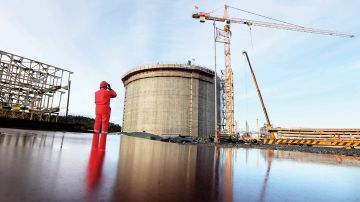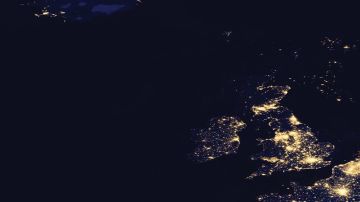THE world has just witnessed a truly significant moment in the history of petrochemicals.
Those shipments of liquefied ethane, which finally docked at Rafnes in Norway in March, will breathe life into INEOS’ European businesses.
But forget the years, many million man hours and 5,000 construction workers it took to build the first two ‘Dragon Ships’ transporting this precious cargo. For those ships are just part of this incredibly inspirational story that is global in scale, breathtaking in its vision.
It is also a story that many on both sides of the Atlantic had dismissed as pure fantasy.
“It had never been done, and many said it couldn’t be done,” said Chad Stephens, Senior Vice President of Corporate Development at Range Resources, which is providing INEOS with the gas it needs.
The arrival of these world-leading vessels, which were built in China, heralds a new era in the transportation of ethane gas.
“Not often do you witness revolutionary moments in our industry, but this is one of them,” said Peter Clarkson, head of investor relations at INEOS.
The difference this competitively-priced ethane will make to INEOS’ European petrochemical business is staggering, both in terms of energy and raw materials. INEOS will use it to power its plants as it turns it into ethylene, one of the world’s most important petrochemicals.
“Shipping US ethane gas to Europe will safeguard our petrochemicals assets in Europe for many years to come,” said John McNally, CEO of INEOS Olefins & Polymers UK.
The story, though, really began six years ago when INEOS dared to think the unthinkable. In 2010 Europe was reeling from the effects of the financial crisis. Energy prices were higher than ever and North Sea gas stocks were dwindling. In America, a revolution was underway. Shale gas had led to low energy and feedstock prices which had revitalised its manufacturing industry. But America had a problem. It had so much ethane that it did not know what to do with it.
A plan was hatched at INEOS’ offices in Rolle, Switzerland, to create a virtual, transatlantic pipeline and bring the gas it desperately needed to secure the future of its European crackers.
But how would INEOS do it?
No one had attempted anything on this scale before.
There was no way to get the gas from the shale wells in south western Pennsylvania to Philadelphia 300 miles away on the east coast of America.
There were no export facilities in the US and no one had ever tried to ship ethane gas in such huge quantities.
To INEOS Chairman Jim Ratcliffe, none of that mattered.
“People said we couldn’t do it,” he said. “But at INEOS we have always believed that anything is possible.”
As INEOS ploughed ahead with its ambitious plans and assembled a team of international partners, spanning three continents, others watched and waited.
“The technology didn’t exist so we had to create it,” said INEOS Director Andy Currie.
David Thompson, Chief Operating Officer INEOS Trading & Shipping, was the man given the task of overseeing the project.
“It has quite simply been one of the biggest engineering projects in the world,” he said. “We are pioneers in this. We have been involved in the pipelines, the fractionation, the terminals, the infrastructure and the ships. We have had to do it all.”
That bold, pioneering plan has now become a reality.
To do it, INEOS struck 15-year deals with ethane suppliers, including Range Resources, to provide the gas, MarkWest to process the gas and Sunoco to pipe it hundreds of miles to the Marcus Hook Industrial Complex where it will be cooled to minus 140 degrees Fahrenheit before being shipped to Norway and later this year Grangemouth in Scotland.
There was no doubt in the minds of all those involved. This was not a problem. This was an opportunity. An opportunity to safeguard the future of businesses in Europe and breathe life back into once-thriving communities in America.
In America work began to convert a former oil products pipeline to carry the ethane on most of its journey from the Marcellus Shale to Marcus Hook, a once bustling oil and gas refinery which had closed in 2011.
Sunoco, which still owned the rusting refinery, began pumping billions of dollars into transforming it into a world-beating chemical production, gas storage and distribution centre to enable INEOS’ fleet of ‘Dragon Ships’ to be loaded with cargo. Elsewhere, 50 miles of new pipes were laid and a new pumping station was installed.
Over in Europe, INEOS partnered with Danish shipping giant Evergas to design ships capable of such a mammoth task.
“It was an enormous task but Evergas understood perhaps better than anyone else what it would take to transport ethane in the quantities sought by INEOS over the distances required,” said Chad.
Evergas did indeed.
“Ethane-capable vessels existed,” said CEO Steffen Jacobsen. “But Evergas, together with its many stakeholders, created the largest and most sophisticated ethane-carriers to date. That ambitious vision from INEOS and Evergas is what has made this shipping project possible.”
In Hamburg, Germany, HSVA worked on an optimised hull to meet the special needs involved in transporting ethane and Wartsila in Finland invented engines that could run entirely on ethane, which not only allowed more room for cargo but would reduce harmful emissions.
Once the designs were complete, Sinopacific Offshore and Engineering, one of the biggest shipbuilders in the world, was given the final piece in the jigsaw. It had to build the ships.
As work began in China, TGE Gas Engineering, one of the world’s leading contractors for the engineering and project management of gas storage, began building another ethane storage tank and infrastructure at INEOS’ Rafnes site to enable it to import ethane from the North American shale gas fields.
Work also began on the construction of new shipping and storage facilities to handle imports of ethane at INEOS’ Grangemouth plant.
For staff at Grangemouth, after months of uncertainty, the feeling of a bright, new dawn was palpable. For just months before that loss-making petrochemical plant had been threatened with closure amid a bitter industrial dispute during which staff had initially rejected the company’s survival plan.
A change of heart eventually paved the way for major investment and a £230 million loan guarantee from the UK Government which meant INEOS could raise the money it needed to build one of the largest ethane storage tanks in Europe. Once built the ethylene cracker will be able to double production.
It has been a mammoth task. But as Jim stood on the bridge of the first ‘Dragon Ship’, aptly named INEOS Ingenuity, he could not disguise his delight.
“It’s wonderful when a plan comes together,” he said. “And it makes you feel very proud to have accomplished something that no one has ever done before.”
















